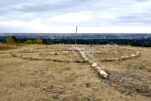The Human Condition: A New Hope
By Daniel Schnee on December 21, 2022.
One evening when I was a child my father decided on a whim to take me to see a new, relatively unanticipated movie. I will never forget the ensuing thrills and chills, and how it would change my life forever. That movie was Star Wars. Nothing could ever come close to equaling the impact that film had on me in terms of science or fiction, or so I thought until two weeks ago when fiction turned into actual science at the Lawrence Livermore National Laboratory in California. Physicists placed a tiny pellet half the diameter of a BB inside a small cylinder then struck the cylinder’s sides with 192 laser beams (i.e. depositing energy into it). This laser activity happened in less time than it takes light to travel 10 feet (light-speed being 186,000 miles per second). X-rays from the wall subsequently struck the pellet, which squeezed its interior material and fused together the centres of the pellet’s (hydrogen) atoms. This process had been done in the past, but thanks to advances in modern technology the two megajoules of energy that the lasers added to the experiment produced a little over three megajoules. This means the physicists had gotten 50 per cent more energy out of the pellet/cylinder than they had put in. The output only lasted for the amount of time it takes light to travel one single inch (i.e. less than a billionth of a second), but humanity has now finally achieved what was once considered the “Holy Grail” of nuclear physics: the creation of an infinitesimally short-lived but actual Sun in a lab. What this means now is we can recreate the manner of the Sun’s energy production, nuclear fusion, which is not only much more efficient but does not produce the dangerous levels of radiation and waste created by our current atom-splitting (fission) reactors. Both fission and fusion still only release a tiny amount of the potential energy in a particle, so this raises the question of how we could safely release all of it. Rather than fuse or split particles, physicists could in theory collide them with the particles from cosmic rays that strike Earth. These special space-particles have the opposite electrical charge as regular particles of matter, and are referred to as “antimatter.” If scientists smashed antimatter together with ordinary matter they would get all possible energy out of the process – extreme amounts from mere kilograms of material – and we could then power the entire planet for a full year with only a few tonnes of material. Unfortunately though our current particle accelerators can only produce less than one millionth of a gram of antimatter a year, and it also happens to be so rare as to be practically nonexistent throughout the entire universe. So though it seems like our premier is trying to drive us off one cliff and our prime minister trying to drive us off another, there is still reason to hope and dream. As we struggle to keep our beloved nation safe from our worst instincts there is new and wondrous sunlight shining out upon our future… even if it only lasts a billionth of a second. Dr. Daniel Schnee is an anthropologist and jazz/rock drummer 11-10
1 Comment
Oldest




